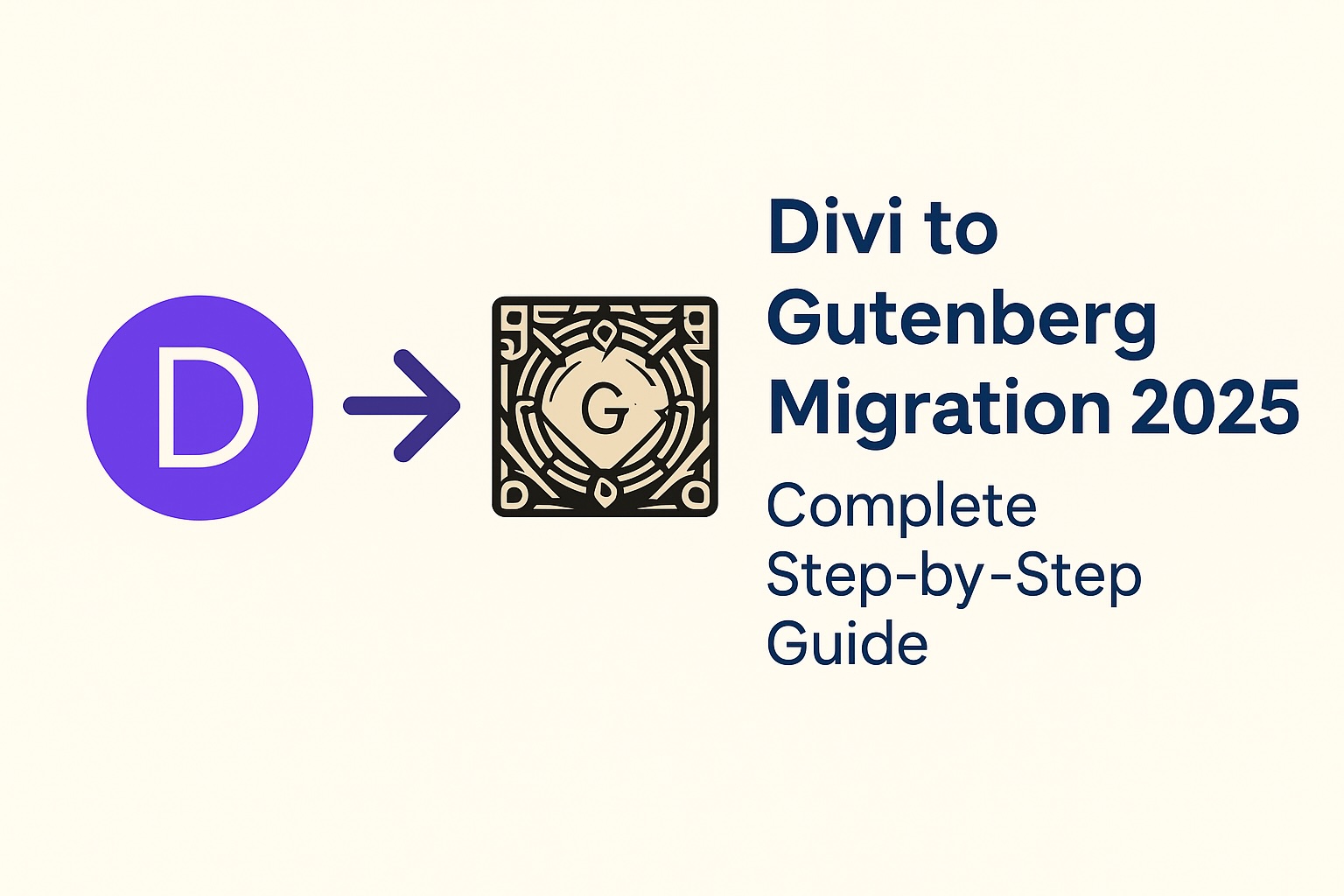Moving from Divi to the native WordPress Block Editor (Gutenberg) can dramatically simplify your stack and improve performance in 2025. This guide walks you through a safe, verifiable, and SEO-friendly migration – covering prep work, tools, a step-by-step plan, QA, and FAQs. We also point to authoritative sources confirming key changes (like Divi 5’s move away from shortcodes and the WordPress 6.8+ release cadence).
We also invite you to explore our other guides related to migrating to Gutenberg:
- Gutenberg WordPress Guide: Complete Tutorial for Beginners and Pros
- Migration from Elementor to Gutenberg: Is It Worth It in 2025?
- Elementor to Gutenberg Migration
- Convert WPBakery to Gutenberg
Table of contents
Why migrate from Divi to Gutenberg in 2025
- Divi 5 removes shortcodes. Elegant Themes rebuilt Divi 5 on a block-like storage format. Their official post states: “Divi 5 comes with a migrator that will convert all of your Divi 4 shortcodes to Divi 5 blocks,” plus a backward-compatibility mode for legacy content. Source.
- Divi 5 status in 2025. Divi 5 is in Public Alpha with bi-weekly updates, approaching Public Beta. See Elegant Themes updates and status pages: Alpha updates, status/changelog, and Divi 5 hub.
- WordPress 6.8+ (released April 15, 2025) brought further block editor maturity; 6.9 is scheduled for December 2, 2025. Dev notes, 6.9 roadmap.
- Cleaner HTML & fewer dependencies. Gutenberg outputs lean markup, reducing reliance on heavy builder CSS/JS bundles, improving Core Web Vitals and maintainability.
- Gradual migration options. The Divi Layout Block lets you embed Divi layouts inside Gutenberg, enabling page-by-page transitions. Docs.
Preparation & audit (don’t skip)
- Back up + staging first. Clone the site to staging (files + DB). Plan a rollback strategy.
- Inventory everything. Pages, posts, CPTs, taxonomies, Divi Theme Builder templates (headers/footers), WooCommerce templates, global modules, shortcodes, sliders, forms.
- Note third-party dependencies. List Divi-specific modules/plugins and check Divi 5/Gutenberg parity.
- Design system extraction. Export palettes, typography, spacing, and components so you can recreate them in
theme.json, patterns, and custom blocks. - Confirm platform versions. Target WordPress 6.8+ and modern PHP. See WordPress dev notes.
Migration tools & helpers
- Divi 5 migrator (built-in). Converts Divi 4 shortcodes to Divi 5 blocks with backward compatibility for legacy/third-party modules. Details.
- Automattic’s “Divi Migration Tools”. Open-source helper plugin aimed at converting Divi content to WordPress. Use on staging and review output. GitHub.
- Divi Layout Block. Embed existing Divi layouts inside Gutenberg to migrate gradually. Docs.
- Block theme +
theme.json. Adopt a block theme or a custom theme withtheme.jsonfor global styles (colors, fonts, spacing). - Reusable blocks & patterns. Convert common sections (hero, CTA, pricing) into patterns for consistency.
- QA toolkit. Lighthouse, WebPageTest, PageSpeed Insights; link checkers; accessibility tools; Schema testing.
Divi → Gutenberg: common replacements
| Divi element | Gutenberg replacement | Notes |
|---|---|---|
| Section / Row / Column | Group / Columns / Stack layout | Use layout controls + gap/spacing in Group/Columns. |
| Blurb | Media & Text / Group + Heading + Paragraph + Image | Create a reusable pattern for repeated blurbs. |
| Button | Buttons block | Map styles to theme.json presets. |
| Image / Gallery | Image / Gallery | Keep descriptive alt text; use native lazy-load. |
| Slider | Cover + Patterns or lightweight slider block/plugin | Prefer minimal JS; avoid heavy sliders where possible. |
| Contact Form | Form plugin block (e.g., core/third-party) | Migrate confirmations, spam protection, GDPR notices. |
| Blog Module | Query Loop | Recreate archive/card layouts with Query Loop variations. |
| Theme Builder header/footer | Block theme template parts | Move header/footer to templates/parts with patterns. |
Step-by-step migration process
- Freeze scope & branch to staging. Lock content changes, create a staging copy, and enable maintenance mode when testing cut-over.
- Baseline metrics. Record Core Web Vitals, Lighthouse scores, top landing pages, and conversion paths.
- Install WordPress 6.8+ and a block theme. Configure
theme.jsonto mirror current palettes/typography. - Trial conversions.
- Option A: Install Divi 5 (Public Alpha on staging only) and test the built-in migrator on a few pages. Divi 5 hub.
- Option B: Test Divi Migration Tools (Automattic) on low-risk content. GitHub.
- Option C: Gradual swap using the Divi Layout Block inside Gutenberg, then rebuild each page natively. Docs.
- Rebuild template parts. Convert Theme Builder headers/footers and archives into block templates and patterns; verify menu, search, and site logo blocks.
- Replace unsupported modules. Where a Divi module lacks a 1:1 block, recreate with Groups/Patterns or a lightweight block plugin; avoid heavy dependencies.
- Content pass. Clean headings (H2/H3 hierarchy), check internal links, update media, add descriptive
alt, and review accessibility. - SEO parity. Keep slugs; confirm canonical/robots; migrate schema; verify sitemaps; ensure breadcrumbs remain consistent.
- QA & performance. Device testing, responsive checks, 404/redirects, forms, search, and speed (LCP, CLS, INP). Compare with baseline.
- Plan the live switch. Choose a low-traffic window; backup; deploy; re-test; monitor logs/lighthouse; roll back if needed.
SEO & performance guardrails
- URLs: keep slugs; if anything changes, add 301s.
- Titles & meta: verify per template. Confirm Open Graph/Twitter Cards.
- Images: compress, set correct sizes, keep
alttext. - Schema: preserve key schema (Org, Product, FAQ, Article). Validate after migration.
- Assets: prefer native blocks +
theme.jsonstyles; minimize extra CSS/JS. - Measure: re-run Lighthouse and compare to your baseline.
How long does a Divi → Gutenberg migration take?
For a 20–40 page marketing site, expect 1–3 weeks including design system extraction, rebuilds, QA, and SEO parity checks. Complex stores/portals (hundreds of pages, WooCommerce, custom modules) may need 4–8+ weeks with phased deployments. Use staging early to derisk unknowns and choose a gradual, page-by-page approach if stakeholders can’t accept a single cut-over window.
Need expert help?
We handle full migrations, including design-system re-implementation, custom blocks/patterns, QA, and SEO safeguards. Explore our WordPress services at DeveloPress and let’s plan your safest path to Gutenberg.
Related reading
- Elementor → Gutenberg Migration (2025) – approach and checklists.
- WordPress 6.9: release date & features – what’s coming December 2, 2025.
FAQ.
Don’t see your question? Drop us a message. We’re always happy to help.
Is Divi 5 stable enough to migrate now?
Divi 5 is in Public Alpha (entering Public Beta soon) with frequent updates. Use it on staging first and follow Elegant Themes’ guidance. Divi 5 hub, status.
Does Divi 5 really remove shortcodes?
Yes. Divi 5 replaces Divi 4’s shortcode storage with a block-like format and includes a migrator to convert existing content. Official announcement.
Can I migrate page-by-page instead of all at once?
Yes. Use the Divi Layout Block to embed Divi layouts inside Gutenberg and rebuild pages gradually. Docs.
Which WordPress version should I target?
Will SEO be impacted during migration?
If you preserve URLs, meta, schema, and internal links-and re-test performance – SEO should remain stable or improve thanks to cleaner markup. We recommend a staged rollout and close monitoring in Search Console.
Can DeveloPress handle the migration end-to-end?
Yes – from audit and design-system mapping to custom blocks, QA, and SEO parity. See our services and request a scoped plan.







